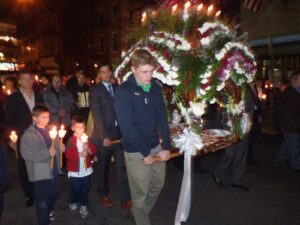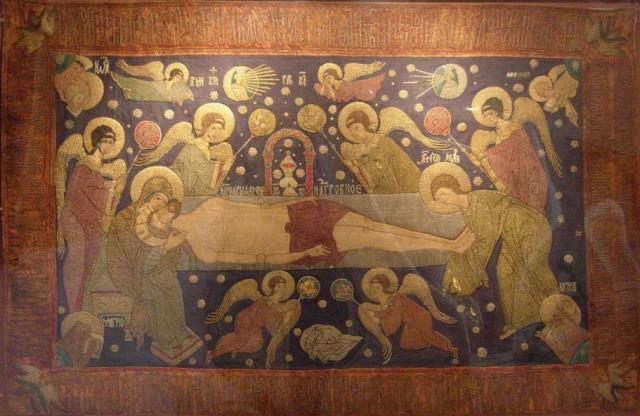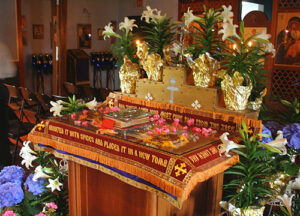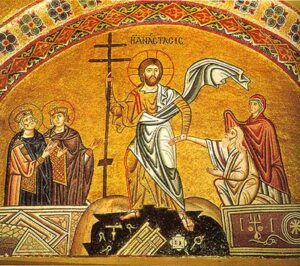
Holy Friday Service – Processing with the Epitaphios
Quite often on the way up to receive Holy Communion, I stop and venerate the tapestry icon that shows Christ’s body “lying in state,” surrounded by the Virgin Mary, the Apostle John, and the angels. Unlike painted icons of Christ hanging vertically on walls, this woven icon is placed on a covered table called in Greek epitaphios.
During the Holy Friday night service the epitaphios is taken outside and processed around the church building much like the way pallbearers carry the body of the deceased out to the burial plot. Link However, in an ironic twist this Holy Friday procession is not one of defeat, but of triumph. Not of loss, but of gain. The early Christians believed that Christ suffered death in order to destroy mankind’s great enemy, Death (1 Corinthians 15:26). As we process around the church building we make our way back to the entrance of the church, this time the epitaphios which bears the tapestry icon of Christ is stationed at the entrance. The only way to enter the church is to walk underneath the epitaphios. It is a beautiful way of symbolizing the fact that our entrance into Paradise is through Christ’s death.
One reason why I like to venerate the icon of Christ’s burial is because as the years go by more and more of my relatives and friends die. As I bow my head to kiss Jesus’ feet I think:
O Death, you have taken so many of my loved ones,
But you, O Death, have been despoiled,
You have been defeated.
For Christ having died has entered into Hades,
And has ransacked Hell setting the captives free;
Jesus Christ is our Champion Leader taking us home to God the Father.
Alleluia!
These personal thoughts of mine reflect the hymns of the Orthodox Church for the Holy Saturday service. On Saturday morning we go to church to celebrate Christ’s descent into Hell to set the captives free. Then we come back late Saturday night for the midnight Resurrection service. Link
“Hell trembled, O Saviour, when he saw Thee, the Giver of Life, despoiling him of his wealth and raising up the dead from every age.”
“Through Thy burial, O Christ, Thou dost destroy the palaces of hell: by Thy death Thou slayest death, and dost deliver from corruption the children of the earth.”
“Source of the river of life, the Wisdom of God descends into the tomb and gives life to all those in the depths of hell.”
Lenten Triodion Second Stasis (pp. 633, 635)
To be a Christian is not just to believe the fact that Jesus rose from the dead but also to trust him to rescue me as well from death. To be a Christian is to have confidence that Christ is able to rescue our family, friends, and loved ones. And it is to have hope in a world where death is no more (Revelation 21:4). Christ is Risen! Truly He is Risen!
Robert Arakaki



Amen! Thank you for your encouraging words!
Thanks
The procession you mention reminds me of Galatians 3:1 “You foolish Galatians! Who has bewitched you? Before your very eyes Jesus Christ was clearly portrayed as crucified.” Could the Orthodox procession trace back that far? 🙂
Prometheus,
Christ is Risen!
If you are referring to the procession with the epitaphios, the answer is that it is a relatively “recent” development in the Orthodox celebration of Holy Week. I put quotation marks around the word recent because this practice emerged in the 1400s or 1500s, which makes it about as old as or older than Protestantism. See Fr. Nabil Hanna’s “The Historical Development of Holy Week in the Orthodox/Byzantine Rite.” However, much of Orthodoxy’s Holy Week services is much older and was described by Cyril of Jerusalem who lived in the fourth century.
Robert
Christ is Risen!
Truly He is Risen!
Robert
Christ is Risen!
Robert,
More and more I am seeing Orthodox theologians refer to the liturgy and other services when they discuss what we believe. I like it! What better evidence on what we believe than how we worship!